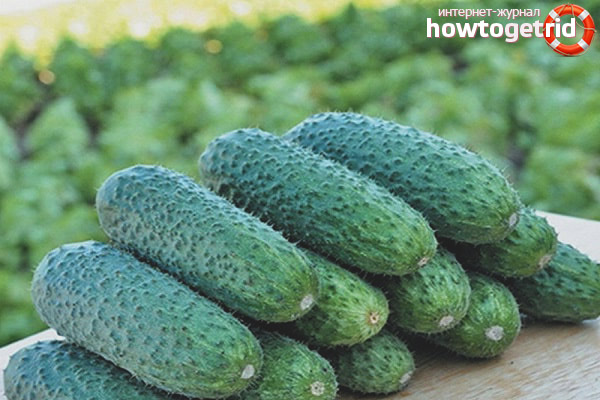The content of the article
Each gardener wants to grow on his plot varieties of vegetable crops that give a high yield. Dutch scientists have bred a lot of varieties of cucumbers suitable for cultivation in different climatic conditions, and with positive characteristics. In 2009, breeders developed the Kibriya variety, which quickly earned the love and recognition of gardeners. However, not everything was fully taken into account, so in 2013 there was an improved version with excellent characteristics - Variety Tchaikovsky. With proper cultivation and compliance with the rules for care, it is able to produce a high yield.
Grade description
Ripening occurs 40 days after sowing seeds. This allows you to plant cucumbers in early spring to collect fruits in the summer, and in the middle of summer to pick ripened fruits until late autumn, down to frosts. The bushes are pollinated independently, which is a favorable factor for the cultivation of cucumbers in enclosed spaces where insect pollinators cannot get.
The bushes are strong, the lashes do not grow long with medium-sized leaves. Plants do not need much space for growth and development. The shape of the fruit is oval. The skin is dark green, there is a light yellow spot near the flower. There are spikes on the surface of the skin, which makes it difficult to pick fruit without gloves.
The average weight of one cucumber is about 60-80 grams. The fruits grow in length to 10-12 cm. The texture of the pulp is dense, crisp, light green in color. The taste is excellent, there is no smack of bitterness.
The variety is adapted for long-term storage fresh. In the refrigerator, cucumbers can lie for about a month, without losing their appearance and taste. For this reason, fruits are often used for long-distance transportation for further sale. In northern areas, it is recommended that indoor use be used for cultivation.
Cultivation agricultural
Tie cucumber lashes to a vertical trellis makes it easier to care for plants and pick ripened fruits. It is important to leave maximum space between neighboring plants so that each bush receives enough nutrition as well as sunlight.
Of great importance is the observance of crop rotation. Re-cucumbers planted on the site only after five years. Otherwise, yield may decrease.
Soil preparation
Land for planting cucumbers should be light and fertile. Water for irrigation should flow unhindered to the root system. Do not plant cucumbers under the scorching sun. So the foliage will quickly lose moisture and wither.
Soil must be prepared in the fall. Rotted manure or compost is brought to the surface of the earth. The soil should be dug in the winter. This will enable her to freeze well, so harmful insects and fungi dangerous for cucumbers will die.
Planting varieties
The method of planting depends on the area and climatic conditions. Variety Tchaikovsky can be sown in 2 crop rotation.For planting in early spring, you must wait until the time when the soil warms up to a temperature of + 14- + 15 degrees. For re-planting, determine the time in the middle of summer. For earlier fruit production, the seedling method is often used.
Seedlings are sown in early April. To do this, prepare suitable containers or special peat pots. Plants do not tolerate density, so you need to plant 1 seed or 2. Subsequently, a weaker sprout is cut with scissors. Sprouts are planted in a permanent place as soon as 2-3 real leaves appear. The surface of the soil must be well moistened. To create better conditions, plants are planted in rows, which will be at a distance of about a meter from each other. Between plants, leave 40 cm of free space. About 4 plants should be placed on one square meter of the plot. If it is supposed to use a vertical trellis for convenient cultivation, then it must be installed in parallel with the planting of cucumbers.
Care Rules
Watering
Cucumbers need timely watering, cultivation and hilling. It is also important to feed regularly. Watering is recommended with warm, settled water. Although cucumbers are a moisture-loving vegetable crop, you should not overdo it with the amount of liquid. About 1 bucket of water is consumed per square meter. After the lashes grow by about 1 meter, the amount of water increases.
In order not to erode the soil near the roots of plants, water must be poured into trenches specially dug nearby. Perform the procedure in the evening or early in the morning. After watering, it is necessary to loosen the soil in order to prevent the formation of a crust, which will interfere with air ventilation at the root system. Along with this, weed grass must be destroyed. Weeds take a lot of useful substances from the earth.
Top dressing
Fertilizer application depends on the cultivation method. For greenhouse plants, before planting, a mixture of superphosphate, ammonium nitrate and sulfuric acid potassium is introduced into the soil. The following top dressing is done in the development phase of 4 leaves. Further, fertilizers should be applied during the formation of the ovaries and the fruit ripening period. After harvesting, the soil is prepared for the next year: mixed with humus.
To control pests and diseases, you can use special insecticides. For preventive purposes, spraying bushes and regular visual inspection. If infected leaves are found, they must be torn off and the plants treated with chemicals. The neighborhood with strongly-smelling plants scares off whiteflies, aphids and ticks. For this, dill, garlic and onions are suitable.
Variety Tchaikovsky is a very high-yielding and unpretentious species. Cucumbers have many positive qualities that are appreciated by gardeners throughout the country. The versatility of the variety allows it to be used for canning, for the preparation of vegetable salads, as well as for eating raw, as an independent product.
Video: Tchaikovsky F1 cucumbers










Submit